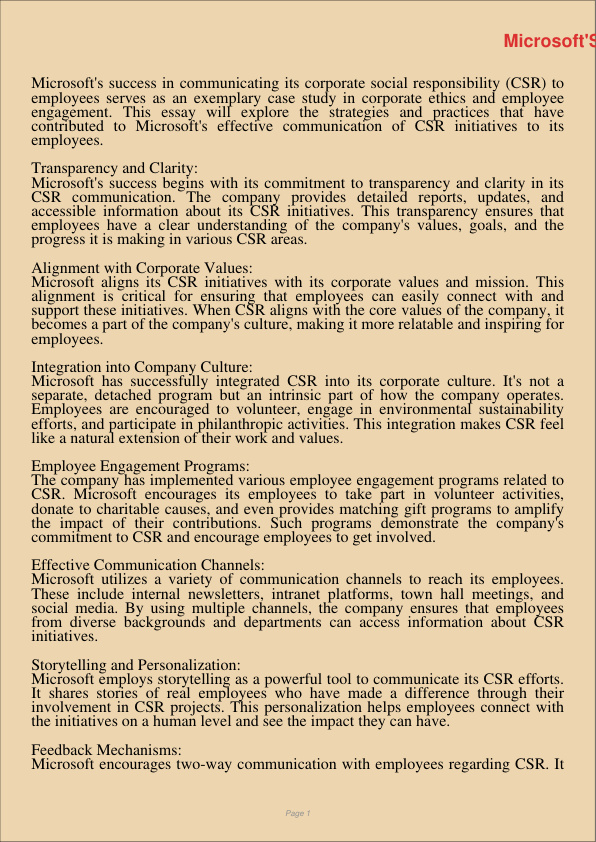MicrosoftS Success In Communicating Its Corporate Social Responsibility To Employees
Jan 9, 2024
corporate social responsibility
success
Health Sciences & Medicine
Law

Microsoft’s success in communicating its corporate social responsibility (CSR) to employees serves as an exemplary case study in corporate ethics and employee engagement. This essay will explore the strategies and practices that have contributed to Microsoft’s effective communication of CSR initiatives to its employees.
Transparency and Clarity: Microsoft’s success begins with its commitment to transparency and clarity in its CSR communication. The company provides detailed reports, updates, and accessible information about its CSR initiatives. This transparency ensures that employees have a clear understanding of the company’s values, goals, and the progress it is making in various CSR areas.
Alignment with Corporate Values: Microsoft aligns its CSR initiatives with its corporate values and mission. This alignment is critical for ensuring that employees can easily connect with and support these initiatives. When CSR aligns with the core values of the company, it becomes a part of the company’s culture, making it more relatable and inspiring for employees.
Integration into Company Culture: Microsoft has successfully integrated CSR into its corporate culture. It’s not a separate, detached program but an intrinsic part of how the company operates. Employees are encouraged to volunteer, engage in environmental sustainability efforts, and participate in philanthropic activities. This integration makes CSR feel like a natural extension of their work and values.
Employee Engagement Programs: The company has implemented various employee engagement programs related to CSR. Microsoft encourages its employees to take part in volunteer activities, donate to charitable causes, and even provides matching gift programs to amplify the impact of their contributions. Such programs demonstrate the company’s commitment to CSR and encourage employees to get involved.
Effective Communication Channels: Microsoft utilizes a variety of communication channels to reach its employees. These include internal newsletters, intranet platforms, town hall meetings, and social media. By using multiple channels, the company ensures that employees from diverse backgrounds and departments can access information about CSR initiatives.
Storytelling and Personalization: Microsoft employs storytelling as a powerful tool to communicate its CSR efforts. It shares stories of real employees who have made a difference through their involvement in CSR projects. This personalization helps employees connect with the initiatives on a human level and see the impact they can have.
Feedback Mechanisms: Microsoft encourages two-way communication with employees regarding CSR. It actively seeks feedback, suggestions, and concerns from employees, which helps in refining CSR strategies and initiatives. This feedback loop demonstrates that the company values employee input and is committed to continuous improvement.
Regular Updates and Progress Tracking: Microsoft provides regular updates on the progress of its CSR initiatives. This practice keeps employees informed about the impact of their efforts and the company’s commitment to achieving its CSR goals. It instills a sense of pride and accomplishment among employees.
In conclusion, Microsoft’s success in communicating its corporate social responsibility to employees is a result of its commitment to transparency, alignment with corporate values, integration into company culture, engaging programs, effective communication channels, storytelling, feedback mechanisms, and progress tracking. The company’s approach not only communicates its dedication to CSR but also fosters a sense of purpose and engagement among its employees. Microsoft’s example serves as a benchmark for other organizations looking to effectively communicate their CSR initiatives to their workforce.